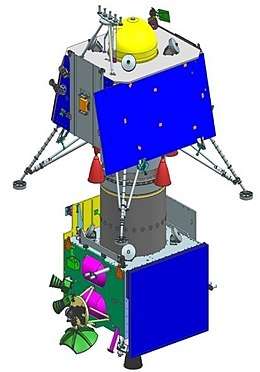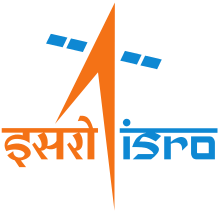Chandrayaan programme
The Chandrayaan programme (![]()
| Country | India |
|---|---|
| Organization | Indian Space Research Organisation (ISRO) |
| Purpose | Exploration of the Moon |
| Status | Active |
| Program history | |
| Cost | ₹1,364 crore (US$190 million)[1][2] |
| Duration | 2008–present |
| Maiden flight | Chandrayaan-1, 22 October 2008 |
| Last flight | Chandrayaan-2, 22 July 2019 |
| Partial failures | 1 |
| Launch site(s) | |
| Vehicle information | |
| Launch vehicle(s) | |
Programme structure
The Chandrayaan (Indian Lunar Exploration Programme) programme is a multiple mission programme. As of August 2020, one orbiter with an impactor probe has been sent to the Moon, using ISRO's workhorse PSLV rocket. The second spacecraft consisting of orbiter, soft lander and rover was launched on 22 July 2019, by using a GSLV Mk III rocket. In a podcast from AT, VSSC director S. Somanath stated that there will be a Chandrayaan-3 and more follow up missions in Chandrayaan Program.[3] Chandrayaan-3 mission is proposed for Q2 2021.[4]
Phase I: Orbiter and Impactor
.jpg)
Prime Minister Atal Bihari Vajpayee announced the Chandrayaan project on course in his Independence Day speech on 15 August 2003. The mission was a major boost to India's space program. The idea of an Indian scientific mission to the Moon was first mooted in 1999 during a meeting of the Indian Academy of Sciences. The Astronautical Society of India carried forward the idea in 2000. Soon after, the Indian Space Research Organisation (ISRO) set up the National Lunar Mission Task Force which concluded that ISRO has the technical expertise to carry out an Indian mission to the Moon. In April 2003 over 100 eminent Indian scientists in the fields of planetary and space sciences, Earth sciences, physics, chemistry, astronomy, astrophysics and engineering and communication sciences discussed and approved the Task Force recommendation to launch an Indian probe to the Moon. Six months later, in November, the Indian government gave the nod for the mission.
The first phase includes the launch of the first lunar orbiters.
- Chandrayaan-1, launched on 22 October 2008 aboard a PSLV-XL rocket, was a big success for ISRO as the Moon Impact Probe, a payload on board the Chandrayaan-1 spacecraft, discovered water on the Moon. Apart from discovering water the Chandrayaan-1 mission performed several other tasks such as mapping and atmospheric profiling of the Moon.
Phase II: Soft landers and rovers

On 18 September 2008, the First Manmohan Singh Cabinet approved the mission.[5][6][7] Although ISRO finalised the payload for Chandrayaan-2 per schedule,[8] the mission was postponed in January 2013[9] and rescheduled to 2016 because Russia was unable to develop the lander on time.[10][11] Roscosmos later withdrew in wake of the failure of the Fobos-Grunt mission to Mars, since the technical aspects connected with the Fobos-Grunt mission were also used in the lunar projects, which needed to be reviewed.[10] When Russia cited its inability to provide the lander even by 2015, India decided to develop the lunar mission independently.[9][12] Chandrayaan-2 was launched on 22 July 2019[13] aboard a GSLV Mk III rocket.
The spacecraft was successfully put into lunar orbit on August 20, 2019 [14] and the lander was lost while attempting to land on 6 September 2019.[15] The orbiter is operational, collecting scientific data,[16] and is expected to function for 7.5 years.[17]
In November 2019, ISRO officials stated that a new lunar lander mission was being studied for launch in November 2020. This new proposal is called Chandrayaan-3 and it would be a re-attempt to demonstrate the landing capabilities needed for the Lunar Polar Exploration Mission proposed in partnership with Japan for 2024.[18] This spacecraft configuration would not include launching an orbiter and would have a lander, rover, and a propulsion module with mission costing ₹ 250 crore with additional launch costs of ₹ 365 crore for GSLV Mk III.[19][20] Third mission would land in the same area as the second one.[21]
Phase III: On site sampling
The next mission will be Lunar Polar Exploration Mission, suggested to be launched in 2024.[22][23][24] India is collaborating with Japan in this mission but the mission is not yet defined. Most likely it will be a lander-rover mission to perform on site sampling and analysis of collected lunar material[25][26] and demonstrate lunar night survival technologies.[27]
See also
- Indian Space Research Organization
- Exploration of the Moon – Various missions to the Moon
References
- "Chandrayaan-2 mission cheaper than Hollywood film Interstellar - Times of India". The Times of India. Retrieved 2019-08-27.
- "Question No. 2222: Status of Chandrayaan Programme" (PDF). Archived from the original (PDF) on 2017-08-03.
- "Episode 90 – An update on ISRO's activities with S Somanath and R Umamaheshwaran". AstrotalkUK. October 24, 2019. Retrieved October 30, 2019.
- "A mix of young and middle-aged people will train for Gaganyaan". The Week. Retrieved 2020-05-04.
- Sunderarajan, P. (19 September 2008). "Cabinet clears Chandrayaan-2". The Hindu. Retrieved 23 October 2008.
- "ISRO completes Chandrayaan-2 design". Domain-b.com. 17 August 2009. Retrieved 20 August 2009.
- "India and Russia complete design of new lunar probe". Sputnik News. RIA Novosti. 17 August 2009. Retrieved 20 August 2009.
- "Payloads for Chandrayaan-2 Mission Finalised" (Press release). Indian Space Research Organisation. 30 August 2010. Retrieved 4 January 2010.
- Ramachandran, R. (22 January 2013). "Chandrayaan-2: India to go it alone". The Hindu.
- Laxman, Srinivas (6 February 2012). "India's Chandrayaan-2 Moon Mission Likely Delayed After Russian Probe Failure". Asian Scientist. Retrieved 5 April 2012.
- "India's next moon mission depends on Russia: ISRO chief". NDTV. Indo-Asian News Service. 9 September 2012.
- "Chandrayaan-2 would be a lone mission by India without Russian tie-up". Press Information Bureau, Government of India. 14 August 2013.
- ISRO set for April launch of Chandrayaan-2 after missed deadline. Vikram Gopal, Hindustan Times. 11 January 2019.
- "Chandrayaan-2 update: Lunar Orbit Insertion". 20 August 2019.
- "Chandrayaan 2 contact loss". 11 September 2019.
- "Chandrayaan 2 orbiter operational". 26 September 2019.
- "Chandrayaan 2 orbiter operational life". 7 September 2019.
- https://thewire.in/space/isro-chandrayaan-3-lunar-lander-rover-gaganyaan ISRO Will Embark on Chandrayaan 3 by November 2020 for Another Landing Attempt. The Wire. 14 November 2019.
- Jan 2, Chethan Kumar | TNN | Updated:; 2020; Ist, 4:08. "Chandrayaan-3 to cost Rs 615 crore, launch could stretch to 2021 | India News - Times of India". The Times of India. Retrieved 2020-01-03.CS1 maint: extra punctuation (link) CS1 maint: numeric names: authors list (link)
- "2nd Lunar landing effort by ISRO". 14 November 2019.
- "Chandrayaan-3: India plans third Moon mission". BBC News. 1 January 2020.
- Shimbun, The Yomiuri (2019-07-30). "Japan, India to team up in race to discover water on moon". The Japan News. Retrieved 2019-07-30.
- After Mars, ISRO to Set a Date with Venus. Archived 2019-07-16 at the Wayback Machine Trak. Malvika Gurung. 20 May 2019.
- After Reaching Mars, India's Date With Venus In 2023 Confirmed, Says ISRO. U. Tejonmayam, India Times. 18 May 2019.
- https://www.thehindu.com/sci-tech/science/india-japan-working-on-lunar-sample-return-mission/article20533828.ece "The Hindu". 17 November 2017.
- "Episode 82: Jaxa and International Collaboration with Professor Fujimoto Masaki". AstrotalkUK. 2019-01-04. Retrieved 2019-06-21.
- Sasaki, Hiroshi (17 June 2019). "JAXA's Lunar Exploration Activities" (PDF). UNOOSA. p. 8. Retrieved 9 July 2019.

